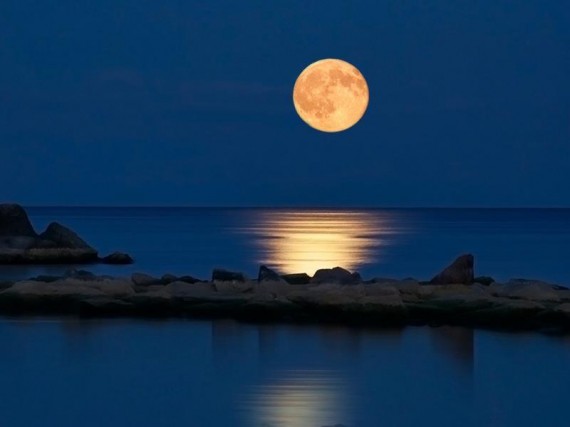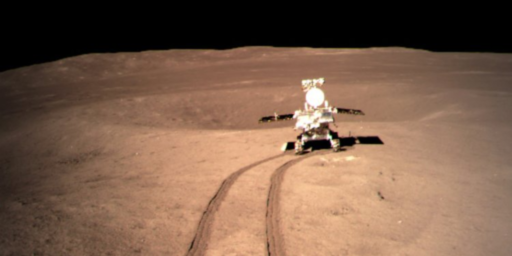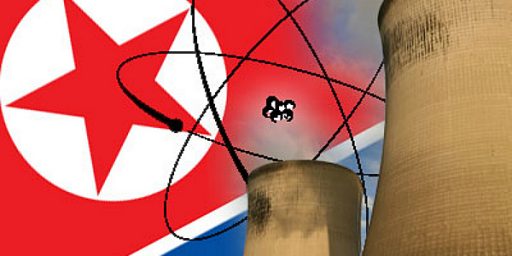Scientists Have A New Theory Of How The Moon Came To Exist
One of the most interesting, and longest running, debates in astronomy has been the question of exactly how the Moon became a satellite of Earth. One theory had it that the Moon was a wandering extra-planetary body that happened to get caught up in the gravity of a young Earth billions of years ago. Another, more recent, theory speculated that the Moon was the result of a collision between Earth and an object as large as Mars. The idea of a young Earth being bombarded by a Mars-sized object billions of years ago is fascinating enough, but now scientists are starting to look in a new direction to explain where the Moon came from:
The Earth and the Moon have always been close in astronomical terms, but now a newly proposed theory from Harvard planetary scientists suggets that they may be more like family.
A really violent family, that is, considering the new theory states that a planetary body half the size of Mars struck Earth moving at a speed of 12-miles-per second, instantly vaporizing but cleaving off a huge chunk of our home planet down to its core and dispersing it into space, and that this material is what coalesced to form the Moon.
The new theory, proposed by Harvard planetary science professor Sarah T. Stewart and Matija Ćuk, a Harvard postdoc and principal investigator at SETIand published in a paper in the journal Science on Wednesday, is actually is itself a combination and tweaking of two other theories — the “giant impact hypothesis” and the “fission hypothesis,” neither of which alone satisfactorily explained how the moon first appeared in Earth’s sky billions of years ago.
(…)
The “giant impact hypothesis,” the previous leading theory behind the Moon’s formation, suggests that a giant, Mars-sized object known as Theia smacked into the Earth over 4.5 billion years ago and broke apart, and that the resulting debris from both the Earth and Theia formed the moon.
But that theory has a few big problems, including the fact that the impactor, Theia, should be responsible for the majority of the Moon’s current composition.
It’s not — in fact, the Moon is much more like Earth (they have nearly identical isotopic signatures, that is, the molecular formations of elements such as silicon, chromium, tungsten and oxygen are similar on both bodies).
So Harvard researchers have tweaked that theory and combining it with another known as the “fission hypothesis,” which states that a part of the Earth’s own crust broke off and drifted away to form the moon.
The “fission hypothesis,” first proposed in 1879 by George H. Darwin, son of revered naturalist Charles Darwin, also has issues of its own. Namely, it requires that the Earth would have been spinning much faster than than it does presently, for which Darwin (the son) had no compelling explanation.
But Stewart and Ćuk can now account for this as well: In their model, the Earth was spinning much more rapidly, such that a “day” at the time of the Moon’s formation was just two or three hours long. This would mean that the composition of the Earth itself was already highly unstable, approaching the point at which it would break apart on its own and with a much more “squished” shape resembling a football, due to the massive rotational forces.
So, the next time you’re looking up at the Moon, you might want to think that you’re very likely looking at a piece of the planet that you call home.
Here’s a video that the Harvard scientists created to demonstrate their hypothesis:






Not only that, there’s a good chance that life sa we know it woud not exist on Earth without the moon. There are some theories that it helps the Earth gravitationally stable, helping it to avoid rapid shifts in the rotation axis cause by the gravity of other bodies in the solar system. If this formation theory is correct, it will be interesting to see if the slower rotation and more spherical shape have helped with our unusual climactic stability.
@Hal 10000:
Indeed., compared with our two closest neighbors, Venus and Mars, we apparently were fortunate enough to hit the sweet spot when it comes to the stability of our climate.
Not a new theory, it’s been around for decades in fact since the first moon rocks were brought back to earth. A similar thing happened to Mars except instead of a large satellite mars got a very unspherical planet.
@Ron Beasley:
Ron… I know, right?
Moon ejection, plate tectonics, evolution… just well beyond the conciousness of most.
This is a case of “not news”, but somehow it’s made it into the news cycle.
Of course, all those “new earth” folks in the US will ignore it. again.
@Hal 10000: You are correct, a large satellite is certainly responsible for making the earth want it is. The gravitational forces of the moon may have actually prolonged the molten core that creates the magnetic field without which out with life as we know it would not be possible.
Technically, the Moon is not a moon. As both Luna doesn’t revolve around Terra but instead both revolve around a common center of gravity, they qualify as twin planets.
It’s just that the center of gravity is within Terra.
@Jenos Idanian #13:
All bodies in space revolve around the barycenter (no relation to the President), so your distinction means nothing. Jupiter is so massive that the barycenter can move outside the surface of the sun. Do we dare call them twin stars?
The barycenter of the Earth-moon system is well within the Earth.
@Ron Beasley:
Sorry Ron, it is a new theory.
Science is not in the habit of rehashing old theories that add nothing to the discussion.
From above:
(my emphasis)
@OzarkHillbilly:
And… as the abstract in science says…
So… not “new”, but more a matter of degrees of knowlege.
Which, is fine with me, as that is how science moves forward.
Still, the video above is cool.
You could do the same thing with a pumkin and a shotuon shell blast, resulting of a combination of blended pumpkin and bullet fragments.
Of course, the pumpkin would have to be spinning, and be large enough to have it’s own gravitational field and iron core…
But yeah, no biggie.
🙂
This part blows my mind. That has to be an awesome amount of energy dissipated in slowing down the earth’s spin by 3/4ths.